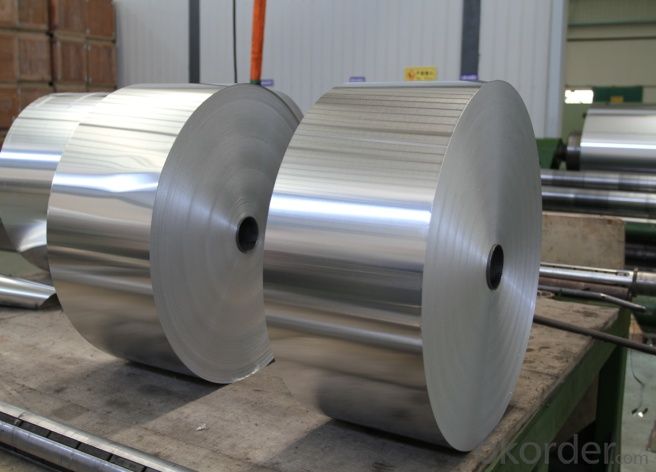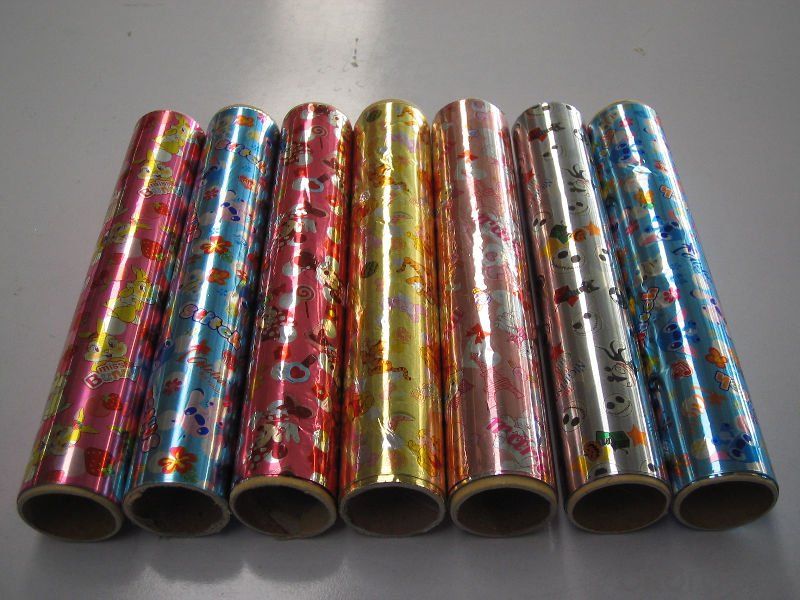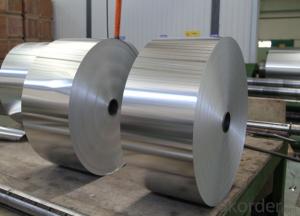8011 1235 3105 Aluminum Foil Manufactured in Roll
- Loading Port:
- Shanghai
- Payment Terms:
- TT OR LC
- Min Order Qty:
- 5 m.t.
- Supply Capability:
- 9000 m.t./month
OKorder Service Pledge
OKorder Financial Service
You Might Also Like
Item specifice
Introduction of Aluminum Foil
Aluminum foil is aluminum prepared in thin metal leaves with a thickness less than 0.2 millimetres (8 mils); thinner gauges down to 6 micrometres (0.24 mil) are also commonly used. In the United States, foils are commonly gauged in thousandths of an inch or mils. Standard household foil is typically 0.016 mm (0.63 mil) thick, and heavy duty household foil is typically 0.024 mm (0.94 mil). The foil is pliable, and can be readily bent or wrapped around objects. Thin foils are fragile and are sometimes lamilated to other materials such as plastics or paper to make them more useful. Aluminum foil supplanted tin foil in the mid 20th century.
Annual production of aluminum foil was approximately 216,000 tonnes (216,000 tons) in LingFeng (our company) one year..Approximately 75% of aluminium foil is used for packaging of foods. household foil,container foil, cosmetics and pharmaceutcal foil etc, and 25% used for industrial applications (e.g. thermal insulation, cables and electronics).
Application of Aluminum Foil:Mainly used in package for food, drinking, cigarette, Pharmaceutical, photograph, daily necessities, power capacitor, construction, auto,boat, celling, lable, etc .
Quality of Aluminum Foil: Totally free from defects like white rust, oil patches, roll marks, edge damage, camber, dents, holes, break lines, scratches and free from coil set.
Chinese Standard of Aluminum Foil: ASTM-B209. EN573-1, GB/T3880.1-2006
Packing for Aluminum Foil: Seaworthy wooden case/box, or as your requirement. ID of aluminum foil roll: 76mm,152mm,200mm,300mm
Kind attention: Specifications can be customized as the customer’s requirements.

Specification of Aluminum Foil
| Alloy No. | Thickness (mm) | Width (mm) | Temper | |
| A1145,A1235,A8011 Household Foil | 0.005-0.2 | 20-1700 | O,H14,H18,H19,H24 | |
| A3003,A8011 Semi Rigid Container Foil | 0.005-0.2 | 20-1700 | O,H14,H18,H19,H24 | |
| A8011,A8021 Pharmaceutical Foil | 0.005-0.2 | 20-1700 | O,H14,H18,H19,H24 | |
| A8011 Foil Label | 0.005-0.2 | 20-1700 | O,H14,H18,H19,H24 | |
| A1145,A1100,A1235,A8001 Fexible Packing Foil | 0.005-0.2 | 20-1700 | O,H14,H18,H19,H24 | |


- Q:Can aluminum sheets be used for lithographic printing plates?
- Indeed, lithographic printing plates can make use of aluminum sheets. Lithographic printing, based on the principle that oil and water do not mix, involves the utilization of a metal base, typically aluminum, coated with a photosensitive layer. This layer is subsequently exposed to light, generating a pattern that serves the purpose of printing. Aluminum stands out as a favored material for lithographic printing plates owing to its exceptional characteristics. It possesses a remarkable combination of being lightweight, yet robust and long-lasting. Furthermore, its smooth surface plays a vital role in ensuring the achievement of high-quality prints. Additionally, aluminum's good thermal conductivity facilitates the rapid drying of ink during the printing process. Moreover, aluminum is highly amenable to processing and can undergo chemical treatment to enhance its surface properties, such as rendering it more hydrophilic or hydrophobic. This enables better control over the ink and water balance on the plate, resulting in prints that are sharper and more precise. In conclusion, the use of aluminum sheets for lithographic printing plates is widespread due to their desirable properties and suitability for the lithographic printing process.
- Q:1. Why does aluminium resist corrosion?2. How do we make aluminium stronger?3. Why does titanium resist corrosion?4. What properties make titanium ideal to use in jet engines and nuclear reactors?5. Why do we need electricity to make aluminium and titanium?6. Why does recycling aluminium save electricity?Even if you only know the answer to one question the help will be much appreciated :D
- 1. When exposed to air, pure aluminium rapidly forms a passive oxide layer, alumina, which further inhibits aluminium reactions with other elements. 2. Aluminium can be made stronger by alloying with other elements. One of the most known aluminum alloy is duraluminium, where the principal alloying component is copper. 3. Exactly as aluminium, titanium corrosion resistance is due to its high reactivity with oxygen. When pure titanium is exposed to air it forms a passive titanium dioxide layer on the surfaces exposed which further prohibits other reactions with corrosion agents. 4. The use of titanium in jet engines components is favored by its strength to weight ration, which is unmatched by any other metal. As for the nuclear reactors, its use is preferred because of its superior corrosion resistance associated with fracture toughness and overall durability. 5. Both titanium and aluminium are refined from their respective mined ores - bauxite, for aluminium, ilmenite and rutile for titanium. Basically, these are oxides of the metals. Pure metal has to be reduced from these ores and processes involve use of temperatures up to and sometime exceeding 1000 degrees Celsius, which obviously requires a great consumption of energy, including electricity. Moreover, pure aluminium is obtained in the final processing phase through electrolysis, meaning an electrical current is needed in order to drive the required chemical reactions, thus adding to the electrical consumption. 6. Recycling aluminium from aluminium simply requires the remelting of the metal, eliminating the electrolytic phase that is high electric energy consuming.
- Q:What are the fire resistance properties of aluminum sheets?
- Due to its high melting point and low thermal conductivity, aluminum sheets possess excellent fire resistance properties. Unlike other commonly used metals like steel, aluminum has a melting point of approximately 660 degrees Celsius, signifying its ability to withstand high temperatures without compromising its structural integrity. Moreover, aluminum's low thermal conductivity minimizes heat transfer, thereby hindering fire propagation and limiting the spread of heat to neighboring areas. In addition, aluminum does not release toxic gases or emit hazardous fumes when exposed to fire, rendering it a secure material for fire-prone environments. These fire-resistant characteristics have made aluminum sheets a preferred choice in numerous applications that prioritize fire safety, including aircraft, building, and automotive component construction.
- Q:Can aluminum sheet be used for cookware?
- Yes, aluminum sheet can be used for cookware. Aluminum is a popular choice for cookware due to its excellent heat conductivity, which allows for even heat distribution and quick heating. It is lightweight, durable, and resistant to rust and corrosion. Additionally, aluminum cookware is affordable and relatively easy to clean. However, pure aluminum is a soft metal, so it is often combined with other materials, such as stainless steel or nonstick coatings, to enhance its durability and nonstick properties.
- Q:Can 101 aluminum sheets be painted with automotive-grade finishes?
- Absolutely! It is completely possible to paint 101 aluminum sheets using automotive-grade finishes. These finishes are specifically formulated to stick to different surfaces, including aluminum. However, it is crucial to adequately prepare the aluminum sheets prior to painting in order to achieve optimal adhesion and long-lasting durability of the finish. This might entail cleaning the surface, eliminating any preexisting coatings or impurities, and applying a suitable primer. Furthermore, it is highly advisable to adhere to the manufacturer's instructions for the specific automotive-grade finish being utilized, as they may provide specific guidelines and recommendations for applying the finish to aluminum surfaces.
- Q:Are aluminum sheets resistant to impact and vibration?
- Yes, aluminum sheets are generally resistant to impact and vibration due to their inherent strength and flexibility.
- Q:How does my world Pocket Monster mod aluminum plate synthesize?
- Right on the ball cover and the aluminum ball low and then use the hammer on the anvil.
- Q:hi my house is wired with aluminum wire and we have this light that has been changed 6 times because originally there was a cheap builders light up there that got replaced with a ceiling fan but the ceiling fan was replaced a couple of times since the remote never worked properly on any of the cieling fans so finally we replaced the cieling fan with just a normal light but now the socket got cracked on the new light by accident. The problem is im wondering if it is safe to put another light up because i have heard aluminum wire breaks easy and the wires have been moved around alot. But if i dont replace the light i wont have a light. We also use the correct wire nuts and anti oxidant on the connections. Also when the 4 cieling fans that had been put up were wired correctly since i have put up many cieling fans up without remotes before. Also Is there a certain number of times aluminum or copper wire can be bent with out having to worry about a fire happening or the wire breaking.
- yes aluminum wire is susceptible to stress and braking but only if there is a stress bend or over twisting the wire. As long as you aren't stressing the wire ie: bending repeatedly where it's tacked down or over twisting the ends (which will break on copper as well) then you shouldn't have any problems. just be sure to support any heavy fixtures as the weight can stress the wire. I hope this helps
- Q:What is the coefficient of friction for aluminum sheets?
- The coefficient of friction for aluminum sheets can vary depending on the specific conditions and surfaces involved.
- Q:If something is wrong, what kind of glue can be used for bonding the stainless steel sheet and aluminum sheet? The area may be very big. What are some common or good glue to buy?
- There are two methods: 1 AB glue or epoxy resin adhesive. 2. If the thickness of the two plate is greater than 8MM, it can be fixed by flat screw. Hope to be available.
1. Manufacturer Overview |
|
|---|---|
| Location | |
| Year Established | |
| Annual Output Value | |
| Main Markets | |
| Company Certifications | |
2. Manufacturer Certificates |
|
|---|---|
| a) Certification Name | |
| Range | |
| Reference | |
| Validity Period | |
3. Manufacturer Capability |
|
|---|---|
| a)Trade Capacity | |
| Nearest Port | |
| Export Percentage | |
| No.of Employees in Trade Department | |
| Language Spoken: | |
| b)Factory Information | |
| Factory Size: | |
| No. of Production Lines | |
| Contract Manufacturing | |
| Product Price Range | |
Send your message to us
8011 1235 3105 Aluminum Foil Manufactured in Roll
- Loading Port:
- Shanghai
- Payment Terms:
- TT OR LC
- Min Order Qty:
- 5 m.t.
- Supply Capability:
- 9000 m.t./month
OKorder Service Pledge
OKorder Financial Service
Similar products
New products
Hot products
Hot Searches
Related keywords





























